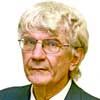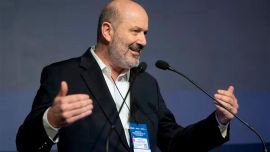With the election campaign now entering its final fortnight, both sides of the political divide have found significant occasions to flag the faith – the government (with Peronist Loyalty Day two weekends ago a far cry from being a red-letter day of unity) commemorated the 11th anniversary of Néstor Kirchner’s death on Wednesday, while today marks 38 years since the Radical landslide win of Raúl Alfonsín in 1983.
Within this anniversary duel the Peronists win out in terms of accuracy at least – last Wednesday really was the same date as Néstor Kirchner’s census day death in 2010 whereas the Radicals were off target in picking Thursday for their Ferro stadium rally. That day neither matched today’s election anniversary nor that exhilarating downtown Radical campaign climax drawing around a million people and confirming that victory against all the odds was possible (October 26, 1983).
Instead last Thursday’s 1983 anniversary was the Peronist response. That amazing Radical feat of the million-strong rally filling much of the Nueve de Julio thoroughfare two days previously had raised the bar, prompting a lot of “game over” talk that the Peronists could never match it but never underestimate them and they did with a million of their own (such numbers seem even more incredible amid the current political fatigue). Yet that very success was their undoing – their thuggish Buenos Aires gubernatorial candidate Herminio Iglesias was so overjoyed by meeting the challenge that he burned a Radical “coffin,” a display of violence alienating a citizenry sickened by years of military junta bloodshed. Electoral outcomes can sometimes hinge on such details (like the Olivos birthday party far more recently). Perhaps last Thursday was the real anniversary of the 1983 Radical victory after all.
The more distant anniversary interests me more today for reasons related to both past and future. While newsroom memories of the 1983 elections abound from my first year at the Buenos Aires Herald, I was nowhere close on the day Néstor died, which found me in Calcutta. That was one of the most surrealistic experiences in my life. Already slightly surprised to see images of Lionel Messi daubed on more than one Calcutta slum wall but that was nothing compared to my astonishment when walking along a downtown street, I looked into a television shop window and saw 50 screens, all with visages of Néstor Kirchner squinting back at me – how on earth had he managed to follow me 16,500 kilometres away to India?
Moving on to nowadays, last Thursday’s commemoration of the 2003-2007 president’s death in Morón really does not tell us very much – more of the contradictory babble increasingly typical of a fragmented coalition. President Alberto Fernández, the only speaker, was theatrically defiant of the International Monetary Fund (“no agreement to date because we refuse to kneel”) but today might well see him meeting up with IMF Managing Director Kristalina Georgieva at the G20 summit in Rome and perhaps even grovelling a bit. Yet that remains unlikely because the reality remains that neither the government nor the IMF have any real urgency to reach an agreement because it is more trouble than it is worth for both for entirely different reasons. Blaming businessmen for inflation will not bring an agreement closer either. Meanwhile the widow was absent from the commemoration but then she always is – if she prefers to remember her husband in private rather than in public, that is her prerogative.
A look at the opposition in general and the Radicals in particular (in the light of today’s anniversary) could bring us closer to a glimpse into the future. City Mayor Horacio Rodríguez Larreta might be the most popular politician in the country and a presidential frontrunner but Radicals probably accounted for over 40 percent of that 40 percent of the vote garnered by the Juntos por el Cambio opposition in last month’s PASO primaries, thus placing them more or less on a par with their main coalition partners PRO (who cannot claim all the remaining Juntos votes).
A pivotal force beyond doubt (the Facundo Manes list was clearly the game-changer in last month’s Buenos Aires provincial upset) but who exactly are the Radicals, it also needs to be asked? Marking their 130th anniversary last June, this force straddling three centuries has always shown a party ethos extremely rare in Argentina’s highly personalised politics but nor are they mere clones. Their first two presidents fell out (with the opposing factions named Personalistas and Antipersonalistas). In the 1956-1972 period the party was formally divided between the mainstream UCRP and the UCRI (Intransigents) founded by Arturo Frondizi, not just by faction. Even Alfonsín, so fondly remembered today, came from a fringe centre-left line (Renewal and Change) with the party establishment backing Fernando de la Rúa in the 1983 Radical primaries.
Nor has the party history been ideologically monolithic. At the time of their foundation the Radicals were a middle-class ruling party in much of Mediterranean Europe, nicknamed “radishes” for being red outside and white inside – the historic range of Radical policies from the extreme state intervention of the Avellaneda Programme (1943) to the conservatism of De la Rúa or Marcelo T. de Alvear is true to that image.
And who is the most representative Radical figure today? The up and coming novice Manes? Party chairman Alfredo Cornejo (a typical Mendoza conservative) or Jujuy Governor Gerardo Morales who opposed joining the Cambiemos front at the 2015 Radical convention in Gualeguaychú and who voted for the wealth tax last year? Sophisticated economists like the two Martíns (Senator Lousteau and City Congress candidate Tetaz)?
Such diversity (far from exhausted by the above list) presumably plays into Rodríguez Larreta’s hands despite the increased Radical clout yet none of the other coalition partners is directly shadowed by an ex-president as the City Mayor is with Mauricio Macri. Thursday was a key day for PRO as well as for the Radicals celebrating the Alfonsín anniversary in Ferro stadium – Macri loyalists, headed by Patricia Bullrich, thronged to Dolores to accompany the ex-president facing illegal espionage charges. Yet this initiative might also look too much like the mirror image of Vice-President Cristina Kirchner’s “lawfare” political persecution paranoia to give any real boost to a Macri comeback.
To end on a positive note, both the presidents remembered this week could claim to be the best in Argentine history – Néstor Kirchner if success is measured by macro-economic indicators (his twin fiscal and trade surpluses and growth rates aided by global commodity boom and rebound from the 2001-2002 meltdown) and Alfonsín because no leader has been more respected for human warmth.




















Comments